|
The Walter And Eliza Hall Institute Of Medical Research
WEHI (), previously known as the Walter and Eliza Hall Institute of Medical Research, and as the Walter and Eliza Hall Institute, is Australia's oldest medical research institute. Sir Frank Macfarlane Burnet, who won the Nobel Prize in 1960 for his work in immunology, was director from 1944 to 1965. Burnet developed the ideas of clonal selection and acquired immune tolerance. Later, Professor Donald Metcalf discovered and characterised colony-stimulating factors. , the institute hosted more than 750 researchers who work to understand, prevent and treat diseases including blood, breast and ovarian cancers; inflammatory diseases (autoimmunity) such as rheumatoid arthritis, type 1 diabetes and coeliac disease; and infectious diseases such as malaria, HIV and hepatitis B and C. Located in Parkville, Melbourne, it is closely associated with The University of Melbourne and The Royal Melbourne Hospital. The institute also has a campus at La Trobe University. The Director of WEHI, sinc ... [...More Info...] [...Related Items...] OR: [Wikipedia] [Google] [Baidu] |
Harry Brookes Allen
Sir Harry Brookes Allen (13 June 1854 – 28 March 1926) was a noted Australian pathologist. Education Harry Brookes Allen was born at Geelong, Victoria, the son of Thomas Watts Allen. He was educated at Flinders School, Geelong, and in 1869–70 at Melbourne Church of England Grammar School. At the matriculation examination in 1870 he won the exhibitions in classics, mathematics, English and French. At the University of Melbourne he topped the class in every year of his course, and graduated M.B. in 1876, M.D. in 1878, and B.S. in 1879. Career In 1876, Allen was appointed demonstrator in anatomy, in 1882 he became lecturer in anatomy and pathology, and from the beginning of 1883 was professor in these subjects. He was also pathologist at the Melbourne Hospital. He was editor of the Medical Journal of Australia 1879–83, pressure of work obliged him to give up this office. As a result of strong representations the government of Victoria had provided the funds for a bui ... [...More Info...] [...Related Items...] OR: [Wikipedia] [Google] [Baidu] |
Coeliac Disease
Coeliac disease (British English) or celiac disease (American English) is a long-term autoimmune disorder, primarily affecting the small intestine, where individuals develop intolerance to gluten, present in foods such as wheat, rye and barley. Classic symptoms include gastrointestinal problems such as chronic diarrhoea, abdominal distention, malabsorption, loss of appetite, and among children failure to grow normally. This often begins between six months and two years of age. Non-classic symptoms are more common, especially in people older than two years. There may be mild or absent gastrointestinal symptoms, a wide number of symptoms involving any part of the body, or no obvious symptoms. Coeliac disease was first described in childhood; however, it may develop at any age. It is associated with other autoimmune diseases, such as Type 1 diabetes mellitus and Hashimoto's thyroiditis, among others. Coeliac disease is caused by a reaction to gluten, a group of various prote ... [...More Info...] [...Related Items...] OR: [Wikipedia] [Google] [Baidu] |
Gordon Mathison
Gordon Clunes Mackay Mathison FRCP (10 August 188318 May 1915) was a physician, medical researcher, and soldier. Appointed the first director of the Walter and Eliza Hall Institute of Medical Research in Melbourne, Australia, he died on 18 May 1915, from wounds received in action on 10 May 1915 during the Gallipoli campaign, before he could take up the position. Family The eldest of the three children of Hector Munro Mathison (1850-1895), a State School headmaster, and Mary Martha Mathison (1860-1942), née Barber, Gordon Clunes Mackay Mathison was born at Stanley, near Beechworth, Victoria on 10 August 1883. An older brother, also known as Gordon Clunes Mackay Mathison, had died on 13 January 1883, aged six months. Soon after his birth, the family moved to Elsternwick, Victoria, where both his father and younger brother Robert Mackay (born 1894) died in 1895. Education Primary He attended Elsternwick State School, where his father and mother both taught, and his father w ... [...More Info...] [...Related Items...] OR: [Wikipedia] [Google] [Baidu] |
Walter Russell Hall
Walter Russell Hall (22 February 1831 – 13 October 1911) was an Australian businessman and philanthropist. Biography Hall was born in Kington, Herefordshire, England, eldest son of Walter Hall, glover (later a miller), and his wife Elizabeth Carleton, ''née'' Skarratt. He was educated in Kington and Taunton, Somerset. Hall arrived in Sydney on 14 February 1852 with his two brothers, Thomas Skarratt Hall and James Wesley Hall with little money. Hall was employed for a short time by David Jones Limited and then prospected for gold in Victoria with meagre success. From 1857 he was a major investor and administrator of the Australian stagecoach line Cobb and Co. He was also an original shareholder and director of Mount Morgan Gold Mining Company Limited, incorporated in 1886. Other directorships included the Mercantile Mutual Insurance Co. Ltd, and the Sydney Meat Preserving Co. Ltd. Hall married Melbourne-born Eliza Rowdon Kirk in 1874. They had no children. He died at the ... [...More Info...] [...Related Items...] OR: [Wikipedia] [Google] [Baidu] |
Eliza Hall
Eliza Rowdon Hall (26 November 1847 – 14 February 1916) was an Australian philanthropist. Born Eliza Rowdon Kirk, she married the Sydney businessman Walter Russell Hall in Melbourne in April 1874. After Walter's death in 1911, Eliza, who was childless, founded The Walter and Eliza Hall Trust that led to the establishment of the Walter and Eliza Hall Institute of Medical Research, using funds earned from Hall's business interests to establish the Trust. Grants from the Trust led to the establishment of the Walter and Eliza Hall Institute of Medical Research WEHI (), previously known as the Walter and Eliza Hall Institute of Medical Research, and as the Walter and Eliza Hall Institute, is Australia's oldest medical research institute. Sir Frank Macfarlane Burnet, who won the Nobel Prize in 1960 for .... References External links * 1847 births 1916 deaths Australian women philanthropists Philanthropists from Melbourne 19th-century Australian women 20th-century A ... [...More Info...] [...Related Items...] OR: [Wikipedia] [Google] [Baidu] |
Eliza Rowden Hall, Marble Bust
ELIZA is an early natural language processing computer program created from 1964 to 1966 at the MIT Artificial Intelligence Laboratory by Joseph Weizenbaum. Created to demonstrate the superficiality of communication between humans and machines, Eliza simulated conversation by using a "pattern matching" and substitution methodology that gave users an illusion of understanding on the part of the program, but had no built in framework for contextualizing events. Directives on how to interact were provided by "scripts", written originally in MAD-Slip, which allowed ELIZA to process user inputs and engage in discourse following the rules and directions of the script. The most famous script, DOCTOR, simulated a Rogerian psychotherapist (in particular, Carl Rogers, who was well known for simply parroting back at patients what they had just said), and used rules, dictated in the script, to respond with non-directional questions to user inputs. As such, ELIZA was one of the first chatterb ... [...More Info...] [...Related Items...] OR: [Wikipedia] [Google] [Baidu] |
Walter Russell Hall, Marble Bust
Walter may refer to: People * Walter (name), both a surname and a given name * Little Walter, American blues harmonica player Marion Walter Jacobs (1930–1968) * Gunther (wrestler), Austrian professional wrestler and trainer Walter Hahn (born 1987), who previously wrestled as "Walter" * Walter, standard author abbreviation for Thomas Walter (botanist) ( – 1789) Companies * American Chocolate, later called Walter, an American automobile manufactured from 1902 to 1906 * Walter Energy, a metallurgical coal producer for the global steel industry * Walter Aircraft Engines, Czech manufacturer of aero-engines Films and television * ''Walter'' (1982 film), a British television drama film * Walter Vetrivel, a 1993 Tamil crime drama film * ''Walter'' (2014 film), a British television crime drama * ''Walter'' (2015 film), an American comedy-drama film * ''Walter'' (2020 film), an Indian crime drama film * ''W*A*L*T*E*R'', a 1984 pilot for a spin-off of the TV series ''M*A*S*H'' * ''W ... [...More Info...] [...Related Items...] OR: [Wikipedia] [Google] [Baidu] |
WEHI Building 2013
WEHI (), previously known as the Walter and Eliza Hall Institute of Medical Research, and as the Walter and Eliza Hall Institute, is Australia's oldest medical research institute An institute is an organisational body created for a certain purpose. They are often research organisations (research institutes) created to do research on specific topics, or can also be a professional body. In some countries, institutes can .... Sir Frank Macfarlane Burnet, who won the Nobel Prize in 1960 for his work in immunology, was director from 1944 to 1965. Burnet developed the ideas of clonal selection and acquired immune tolerance. Later, Professor Donald Metcalf discovered and characterised colony-stimulating factors. , the institute hosted more than 750 researchers who work to understand, prevent and treat diseases including blood cancer, blood, breast cancer, breast and ovarian cancers; inflammatory diseases (autoimmunity) such as rheumatoid arthritis, Diabetes mellitus type 1, type 1 ... [...More Info...] [...Related Items...] OR: [Wikipedia] [Google] [Baidu] |
Molecular Biologist
Molecular biology is the branch of biology that seeks to understand the molecular basis of biological activity in and between cells, including biomolecular synthesis, modification, mechanisms, and interactions. The study of chemical and physical structure of biological macromolecules is known as molecular biology. Molecular biology was first described as an approach focused on the underpinnings of biological phenomena - uncovering the structures of biological molecules as well as their interactions, and how these interactions explain observations of classical biology. In 1945 the term molecular biology was used by physicist William Astbury. In 1953 Francis Crick, James Watson, Rosalind Franklin, and colleagues, working at Medical Research Council unit, Cavendish laboratory, Cambridge (now the MRC Laboratory of Molecular Biology), made a double helix model of DNA which changed the entire research scenario. They proposed the DNA structure based on previous research done by Ro ... [...More Info...] [...Related Items...] OR: [Wikipedia] [Google] [Baidu] |
La Trobe University
La Trobe University is a public research university based in Melbourne, Victoria, Australia. Its main campus is located in the suburb of Bundoora. The university was established in 1964, becoming the third university in the state of Victoria and the twelfth university in Australia. La Trobe is one of the Australian verdant universities and also part of the Innovative Research Universities group. La Trobe's original and principal campus is located in the Melbourne metropolitan area, within the northern Melbourne suburb of Bundoora. It is the largest metropolitan campus in the country, occupying over . It has two other major campuses located in the regional Victorian city of Bendigo and the twin border cities of Albury-Wodonga. There are two smaller regional campuses in Mildura and Shepparton and a city campus in Melbourne's CBD on Collins Street and in Sydney on Elizabeth Street. La Trobe offers undergraduate and postgraduate courses across its two colleges of Arts, Social ... [...More Info...] [...Related Items...] OR: [Wikipedia] [Google] [Baidu] |
Parkville, Victoria
Parkville is an inner-city suburb in Melbourne, Victoria (Australia), Victoria, Australia, north of Melbourne's Melbourne City Centre, Central Business District, located within the Cities of City of Melbourne, Melbourne and City of Merri-bek, Merri-bek Local government areas of Victoria, local government areas. Parkville recorded a population of 7,074 at the 2021 Australian census, 2021 census. Parkville is bordered by North Melbourne, Victoria, North Melbourne to the south-west, Carlton, Victoria, Carlton and Carlton North, Victoria, Carlton North to the south and east, Brunswick, Victoria, Brunswick to the north (where a part of Parkville lies within the City of Merri-bek), and Flemington, Victoria, Flemington to the west. The suburb includes the postcodes 3052 and 3010 (University). The suburb encompasses Royal Park, Melbourne, Royal Park, an expansive parkland which is notable as home to the Royal Melbourne Zoological Gardens and was the athlete's village for the 2006 Commo ... [...More Info...] [...Related Items...] OR: [Wikipedia] [Google] [Baidu] |






